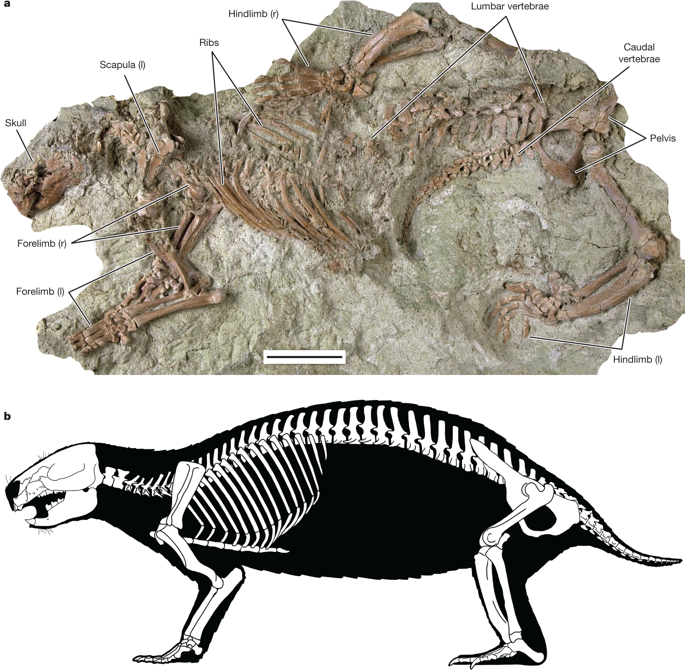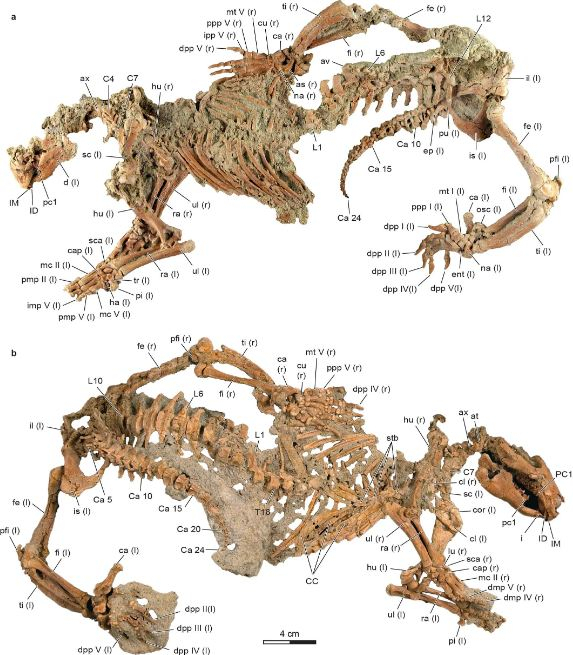When animal fossils from millions of years ago are discovered, they provide a better picture of what the fauna at that time could have looked like. Sometimes, the unearthing of these pre-historic time capsules can leave scientists scratching their heads. One such discovery is the nearly-complete fossilized remains of a "bizarre" mammal that lived 66 million years ago on the island of Madagascar.
Named Adalatherium, which means "crazy beast" in Greek and Malagasy, the skeleton of the animal is the most complete of any mammal from the Mesozoic era (252 to 66 million years ago) uncovered in the southern hemisphere. The fossil was found by an international team of researchers led by Dr. David Krause from Stony Brook University.
What makes this animal strange is that it has several "unusual" features that have never been seen in any known mammals, living or extinct. Highlighting the odd anatomy of the creature Dr. Krause said in a statement, "Knowing what we know about the skeletal anatomy of all living and extinct mammals, it is difficult to imagine that a mammal like Adalatherium could have evolved; it bends and even breaks a lot of rules."

A mammal of unseen 'oddities'
The mammal which bears a resemblance to a modern-day badger in 3-D reconstruction is far from the "normality" associated with mammals of the current era. Its skeleton is "outlandish", according to the researchers. For example, its snout alone has features that are a combination of several known and unknown characteristics. "Its nasal cavity exhibits an amazing mosaic of features, some of which are very standard for a mammal, but some that I've never seen in anything before," declared Dr. James B. Rossie, co-author of the study.
It also had more foramina (holes) on its facial bones than any recorded mammal. The holes acted as pathways between blood vessels and nerves that made Adalatherium's whisker-covered snout extremely sensitive. Also, a large hole was found on top of its snout; something that has never been observed in any known mammal.

Adding to its baffling anatomy is its teeth, whose formation is greatly different from any discovered mammal. In addition to that, it has more vertebrae in its backbone that any Mesozoic mammal, with a peculiar curvature on one it legs. Hence, predicting the very pattern of its movement is a challenge, the scientists aver. "Adalatherium is the oddest of oddballs. Trying to figure out how it moved is nearly impossible because, for instance, its front end is telling us a different story than its back end."
While the scientists are still unpacking the clues from the fossilized remains, they make educated guesses about the mysterious creature. They believe that it could have been a powerful digger and a capable runner, and perhaps with other forms of locomotion as well.
Belonging to an extinct family of mammals
Adalatherium is part of an extinct group of mammals that are known as "gondwanatherians", as they belonged to the supercontinent in the southern hemisphere of the earth. With millions of years of gradually tectonic shifting, Madagascar finally broke away and drifted into an island of its own 88 million years ago.

This isolation from the mainland gave the animal around 20 million years to "develop its many ludicrous features", said Krause. Fossils of this class of mammals have been found across several countries that were part of this massive supercontinent and not just Madagascar.
Gondwanatherians were believed to be related to modern-day anteaters, armadillos and sloths. Krause explained that these mammals "now are known to have been part of a grand evolutionary experiment, doing their own thing, an experiment that failed and was snuffed out in the Eocene, about 45 million years ago".
Also, Adalatherium was found entombed within rocks that dated back to the end of the Cretaceous period when enormous crocodiles and dinosaurs inhabited earth. However, unlike most mammals that lived alongside these reptilian giants and grew only to the sizes of a mouse, the weird beast is unusually big. Before its discovery, only fragments of jaws and teeth of other gondwanatherians were found.

New insights into gondwanatherians
With the discovery of Adalatherium in its nearly complete and excellently preserved state, it offers new insights into how these ancient mammals survived and looked. Yet the oddity of the opossum-sized mammal's features leaves the scientists wondering how bizarre these creatures could have been.
Unlike the remains of early mammals from the northern hemisphere that existed around the same time and were relatively better preserved, those of their southern hemisphere counterparts have not. Therefore, Adalatherium's discovery is especially significant in that regard.
"Adalatherium is just one piece, but an important piece, in a very large puzzle on early mammalian evolution in the southern hemisphere. Unfortunately, most of the pieces are still missing," noted Krause. However, the scientists agree that there Is much to be learned about this early category of mammals that lived in Madagascar and former regions of Gondwana.









